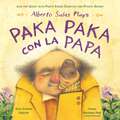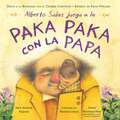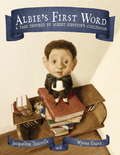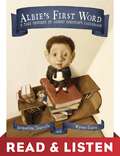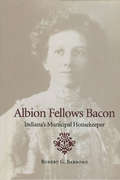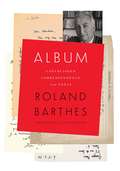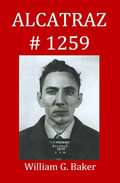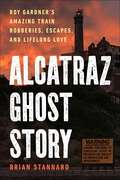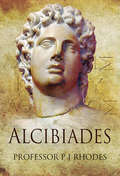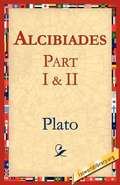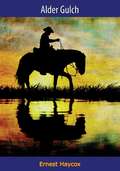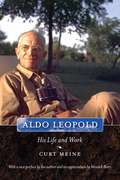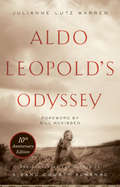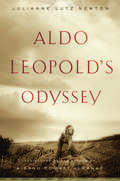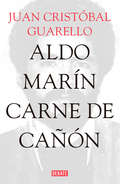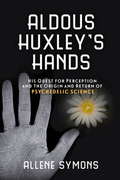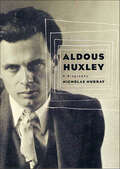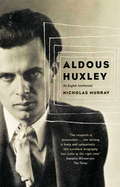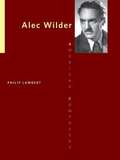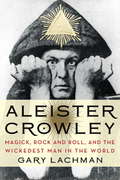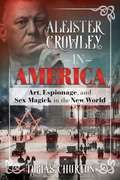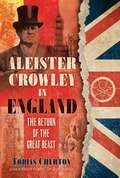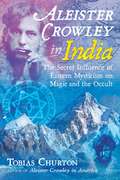- Table View
- List View
Alberto Salas Plays Paka Paka con la Papa: Join the Quest with Peru's Famed Scientist and Potato Expert
by Sara Andrea FajardoWhat can a potato do? To Peruvian scientist Alberto Salas, they have the power to change the world. Go on the hunt with Alberto for for wild potatoes before they go extinct in this playful picture book biography, gorgeously illustrated by Caldecott-honoree Juana Martinez-Neal.High up in the Andes mountains of Peru, agricultural scientist Alberto Salas is on a quest. A quest... for potatoes.Up and down the Andes mountains he goes, playing an epic game of paka paka con la papa, potato hide and seek. These potatoes are special: they have the power to feed the world. Alberto doesn't have a second to waste. The climate is changing and Alberto must find each and every one to save them before they go extinct.The game is on!Alberto races and peers and prods. Drives and trods and climbs. Will he find the potato he seeks? Will he win the game of paka paka con la papa?Author Sara Andrea Fajardo’s spirited biography about “the godfather of potatoes” is paired with lush art by Caldecott-honoree Juana Martinez-Neal to capture how celebrated scientist Alberto Salas brings joy, curiosity, and fun to his very important, life-changing work.
Alberto Salas juega a la paka paka con la papa [Spanish edition]: Únete a la búsqueda con el célebre científico y experto en papas peruano
by Sara Andrea FajardoEsta biografía ilustrada y oda a la conservación y ciencia acompaña al agrónomo peruano Alberto Salas en su búsqueda de papas silvestres antes de que se extingan, con ilustraciones de la ganadora de un Caldecott Honor, Juana Martínez-Neal. Muy alto en la cordillera de los Andes en Perú, el ingeniero agrícola Alberto Salas anda en una búsqueda. En búsqueda… de papas.Arriba y abajo de las montañas va, jugando un juego épico de paka paka con la papa, a las escondidas con la papa. Estos tubérculos son especiales: tienen el poder de alimentar y salvar al mundo.Alberto no tiene tiempo que perder. El clima está cambiando en los Andes y él debe encontrar y rescatar cada una de las variedades de papa antes de que se extingan.¡El juego ya empezó!Alberto corre, busca detenidamente y escarba. Maneja y camina y trepa. ¿Encontrará la papa que busca? ¿Podrá ganar este juego de paka paka con la papa?En su debut como autora con esta energética biografía sobre el “padrino de las papas”, Sara A. Fajardo une fuerzas con el rico y lúdico arte de la ilustradora galardonada con el premio Caldecott, Juana Martinez Neal, capturando cómo el celebrado agrónomo Alberto Salas realiza su imprescindible trabajo con deleite, curiosidad y regocijo.
Albie's First Word: A Tale Inspired by Albert Einstein's Childhood
by Wynne Evans Jacqueline TourvilleHere's a beautiful historical fiction picture book--perfect for the Common Core--that provides a rare glimpse into the early childhood of Albert Einstein, the world's most famous physicist. Three-year-old Albie has never said a single word. When his worried mother and father consult a doctor, he advises them to expose little Albie to new things: a trip to the orchestra, an astronomy lecture, a toy boat race in the park. But though Albie dances with excitement at each new experience, he remains silent. Finally, the thoughtful, quiet child witnesses something so incredible, he utters his very first word: "Why?" Kids, parents, and teachers will be delighted and reassured by this joyous story of a child who develops a bit differently than others."More than a distinctive introduction to Albert Einstein, this book promotes both understanding of difference and scientific curiosity." --Kirkus Reviews, StarredFrom the Hardcover edition.
Albie's First Word: Read & Listen Edition
by Jacqueline TourvilleHere&’s a beautiful historical fiction picture book that provides a rare glimpse into the early childhood of Albert Einstein, the world&’s most famous physicist. Three-year-old Albie has never said a single word. When his worried mother and father consult a doctor, he advises them to expose little Albie to new things: a trip to the orchestra, an astronomy lecture, a toy boat race in the park. But though Albie dances with excitement at each new experience, he remains silent. Finally, the thoughtful, quiet child witnesses something so incredible, he utters his very first word: &“Why?&” Kids, parents, and teachers will be delighted and reassured by this joyous story of a child who develops a bit differently than others.This Read & Listen edition contains audio narration.
Albion Fellows Bacon: Indiana's Municipal Housekeeper
by Robert G. BarrowsAlbion Fellows BaconIndiana’s Municipal HousekeeperRobert G. BarrowsExamines the career of a leading Progressive Era reformer.Born in Evansville, Indiana, in 1865, Albion Fellows was reared in the nearby hamlet of McCutchanville and graduated from Evansville High School. She worked for several years as a secretary and court reporter, toured Europe with her sister, married local merchant Hilary Bacon in 1888, and settled into a seemingly comfortable routine of middle-class domesticity. In 1892, however, she was afflicted with an illness that lasted for several years, an illness that may have resulted from a real or perceived absence of outlets for her intelligence and creativity.Bacon eventually found such outlets in a myriad of voluntary associations and social welfare campaigns. She was best known for her work on behalf of tenement reform and was instrumental in the passage of legislation to improve housing conditions in Indiana. She was also involved in child welfare, city planning and zoning, and a variety of public health efforts. Bacon became Indiana’s foremost "municipal houskeeper," a Progressive Era term for women who applied their domestic skills to social problems plaguing their communities.She also found time to write about her social reform efforts and her religious faith in articles and pamphlets. She published one volume of children’s stories, and authored several pageants. One subject she did not write about was women’s suffrage. While she did not oppose votes for women, suffrage was never her priority. But the reality of her participation in public affairs did advance the cause of women’s political equality and provided a role model for future generations.Robert G. Barrows, Associate Professor of History at Indiana University at Indianapolis, was previously an editor at the Indiana Historical Bureau. He has published several journal articles and book chapters dealing with Indiana history and American urban history, and he coedited (with David J. Bodenhamer) the Encyclopedia of Indianapolis (Indiana University Press).ContentsThe Sheltered LifeThe Clutch of the ThornsAmbassador of the PoorThe Homes of IndianaChild WelfareCity Plans and National Housing StandardsProse, Poetry, and PageantsMunicipal Housekeeper and Inadvertent Feminist
Album: Unpublished Correspondence and Texts (European Perspectives: A Series in Social Thought and Cultural Criticism)
by Roland BarthesAlbum provides an unparalleled look into Roland Barthes's life of letters. It presents a selection of correspondence, from his adolescence in the 1930s through the height of his career and up to the last years of his life, covering such topics as friendships, intellectual adventures, politics, and aesthetics. It offers an intimate look at Barthes's thought processes and the everyday reflection behind the composition of his works, as well as a rich archive of epistolary friendships, spanning half a century, among the leading intellectuals of the day.Barthes was one of the great observers of language and culture, and Album shows him in his element, immersed in heady French intellectual culture and the daily struggles to maintain a writing life. Barthes's correspondents include Maurice Blanchot, Michel Butor, Jacques Derrida, Michel Foucault, Julia Kristeva, Claude Lévi-Strauss, Georges Perec, Raymond Queneau, Alain Robbe-Grillet, Marthe Robert, and Jean Starobinski, among others. The book also features documents, letters, and postcards reproduced in facsimile; unpublished material; and notes and transcripts from his seminars. The first English-language publication of Barthes's letters, Album is a comprehensive testimony to one of the most influential critics and philosophers of the twentieth century and the world of letters in which he lived and breathed.
Alcatraz 1259
by William BakerThis is a true account of life in Alcatraz prison written by William G. Baker 1259AZ, a former prisoner of Alcatraz. This is how we lived, what we thought and said and did, the good and the bad. This is the true story of Alcatraz.
Alcatraz Ghost Story: Roy Gardner's Amazing Train Robberies, Escapes, and Lifelong Love
by Brian StannardThe Incredible True Story of the Most Hunted Man in Pacific Coast History––and the Woman He Loved Before the 1920s found their roar, a charismatic gambling addict named Roy Gardner dominated news headlines with daring train robberies and escapes from incarceration. Nicknamed "the Smiling Bandit," Gardner spilled no blood––except his own––as he cut a felonious path across the western United States, as the country hobbled through a recession in the aftermath of the First World War. Once imprisoned for the long term in federal prisons, including Alcatraz, the most notorious prison's second-most-notorious inmate won over some unlikely champions. Both Gardner's wife, Dollie, and a police officer who once arrested him launched extensive campaigns for Gardner's release on the vaudeville circuit, claiming a brain operation would cure his lawless ways. Was Gardner a good man who made bad decisions as the victim of injury and circumstance? Or was his charming personality merely the poker face of a scoundrel? Richly researched, drawing on contemporary newspaper accounts, Alcatraz Ghost Story explores the life of Roy Gardner in the context of his great love story and the larger backdrop of drug addiction, incarceration, and the racial and labor violence of the 1920s and 1930s.
Alcatraz: The True End of the Line
by Darwin E. CoonAn Autobiography of the Life and Times of Former Inmate Darwin Coon.
Alcibiades
by P. J. RhodesWhile the Americans were fighting in Vietnam, a struggle of even greater strategic significance was taking place in the Middle East: the Sultanate of Oman guards the entrance to the Arabian Gulf, and thus controls the movement of oil from that region. In the 1960s and 70s, the Communists tried to seize this artery and, had they succeeded, the consequences for the West and for the Middle East would have been disastrous — and yet, few people have ever heard of this geo-political drama at the height of the Cold War.In the Service of the Sultan tells, first-hand, the largely unknown story of a small number of British officers who led Muslim soldiers in this hard-fought anti-insurgency war which has shaped todays Gulf. After outlining the historical, geographical and political background, the book describes military action in a stark and mountainous environment, including operations with irregular forces and the SAS as well as action in the air and at sea. The book gives a gripping, moving, funny account of all these and paints a powerful and illuminating picture of the realities of war.It will appeal to all who are interested in the Cold War and relationships between the Western and the Arab worlds. Politics, history, irregular warfare, religion, international affairs: all are ingredients in this absorbing, informative read. In the light of the current insurgencies in Iraq and Afghanistan, it is also timely to be reminded how a rare victory was won over Communist guerrillas.
Alcibiades II
by PlatoThe Second Alcibiades or Alcibiades II (Greek: Ἀλκιβιάδης βʹ) is a dialogue traditionally ascribed to Plato. In it, Socrates attempts to persuade Alcibiades that it is unsafe for him to pray to the gods if he does not know whether what he prays for is actually good or bad for him. <P> <P> There is dispute amongst scholars about the text's authenticity, and it is generally considered apocryphal.[1] The main criticisms of its authenticity revolve around its defective arguments, lack of humor, and style; those who consider it inauthentic date its composition to the 3rd or 2nd centuries BCE.
Alder Gulch
by Ernest HaycoxBLAZIN’ JUSTICEVirginia City, Montana. Gold fever struck hard in 1863, with miners pannin’ for nuggets up and down the length of nearby Alder Gulch. But a gang of guntoughs was ridin’ them roughshod. With the law lookin’ the other way, the sidewinders dealt out hot lead for a man shippin’ his poke or even carryin’ gold dust for his grubstake.Jeff Pierce had been on the hard dodge since Portland, until he staked his claim at Alder Gulch. As a favor, he carried another miner’s poke through the forty miles of danger to Bannack, only to find that the scummy gunhawks had filled the old-timer with buckshot. Now the varmints had Pierce as a marked man. The gang was fixin’ for a showdown, but they’d be a mite less cocky if they knew the charge he was up for—murder!“Ernest Haycox is a master and ALDER GULCH is one of his best.”—Dallas Times Herald
Aldo Leopold
by Curt MeineThis biography of Aldo Leopold follows him from his childhood as a precocious naturalist to his profoundly influential role in the development of conservation and modern environmentalism in the United States. This edition includes a new preface by author Curt Meine and an appreciation by acclaimed Kentucky writer and farmer Wendell Berry.
Aldo Leopold's Odyssey, Tenth Anniversary Edition: Rediscovering the Author of A Sand County Almanac
by Julianne Lutz WarrenIn 2006, Julianne Lutz Warren(néeNewton) asked readers to rediscover one of history's most renowned conservationists. Aldo Leopold's Odyssey was hailed by The New York Times as a "biography of ideas," making "us feel the loss of what might have followed A Sand County Almanac by showing us in authoritative detail what led up to it. " Warren's astute narrative quickly became an essential part of the Leopold canon, introducing new readers to the father of wildlife ecology and offering a fresh perspective to even the most seasoned scholars. A decade later, as our very concept of wilderness is changing, Warren frames Leopold's work in the context of the Anthropocene. With a new preface and foreword by Bill McKibben, the book underscores the ever-growing importance of Leopold's ideas in an increasingly human-dominated landscape. Drawing on unpublished archives, Warren traces Leopold's quest to define and preserve land health. Leopold's journey took him from Iowa to Yale to the Southwest to Wisconsin, with fascinating stops along the way to probe the causes of early land settlement failures, contribute to the emerging science of ecology, and craft a new vision for land use. Leopold's life was dedicated to one fundamental dilemma: how can people live prosperously on the land and keep it healthy, too? For anyone compelled by this question, the Tenth Anniversary Edition of Aldo Leopold's Odyssey offers insight and inspiration.
Aldo Leopold's Odyssey: Rediscovering the Author of A Sand County Almanac
by Julianne Lutz NewtonA household icon of the environmental movement, Aldo Leopold (1887-1948) may be the most quoted conservationist in history. A Sand County Almanac has sold millions of copies and Leopold's writings are venerated for their perceptions about land and how people might live in concert with the whole community of life. But who is the man behind the words? How did he arrive at his profound and poetic insights, inspiring generations of environmentalists? Building on past scholarship and a fresh study of Leopold's unpublished archival materials, Julianne Lutz Newton retraces the intellectual journey generated by such passion and intelligence. Aldo Leopold's Odyssey illuminates his lifelong quest for answers to a fundamental issue: how can people live prosperously on the land and keep it healthy, too? Leopold's journey took him from Iowa to Yale to the Southwest to Wisconsin, with fascinating stops along the way to probe the causes of early land settlement failures, contribute to the emerging science of ecology, and craft a new vision for land use. More than a biography, this articulate volume is a guide to one man's intellectual growth, and an inspirational resource for anyone pondering the relationships between people and the land.
Aldo Marín: Carne de cañon
by Juan Cristóbal GuarelloUna crónica sobre la increíble trayectoria vital de Aldo Marín, un revolucionario chileno desconocido hasta hoy <P><P> La madrugada del jueves 5 de agosto de 1977 dos jóvenes murieron en Turín mientras intentaban cometer un atentado contra el diario La Stampa. Uno de los autores del fallido atentado es un chileno que, durante los días previos, detonó bombas en distintas ciudades italianas. <P>Juan Cristóbal Guarello narra la increíble peripeciavital de Aldo Marín, un joven del norte de Chile que, producto de circunstancias inverosímiles, formó parte del proceso político llevado a cabo por la Unidad Popular. <P>Escapando de la policía secreta y exiliado en México, el protagonista llegó a Cuba para formar parte de una élite militar que tendría por objetivo volver al país para ajusticiar a Pinochet. La llegada de Carlos Altamirano a La Habana a comienzos de 1974 echó por tierra este descabellado y desesperado plan. La historia se traslada entonces a Italia, donde Marín y sus compañeros de armas se encontraron con la insurrección armada que caracterizó a la turbulenta década de los sesenta.
Aldo's Admissions
by Aldo CasilliHow do you say "see you later" to your wife without bursting into tears moments before open heart surgery, knowing full well that this may be the last goodbye? How do you maintain positivity while getting hit again and again with bad news? One day before his wife's 43rd birthday, Aldo was diagnosed with colon cancer which required major surgery to rectify. One week later, he incidentally discovered that he also had some very dangerous heart issues. Aldo had a leaking aortic valve which needed replacing and a 6.7 cm ascending aortic aneurysm which needed repairing, via open heart surgery. He was immediately told to cease all strenuous activity, including his work. Aldo's Admissions tells the story of Aldo's experiences and personal thoughts over a ten-month time span while dealing with all the upsetting news he receives and his fight to stay alive. This book is for anybody who wonders how it feels to be told you have serious health issues which suddenly put your existence on this planet under threat. It is also for anybody who is seeking reassurance to continue fighting these issues. Please sit down, put on your seat belts and enjoy the roller coaster ride. This is Aldo's journey.
Aldous Huxley's Hands
by Allene SymonsPsychedelics, neuroscience, and historical biography come together when a journalist finds a lost photograph of Aldous Huxley and uncovers a hidden side of the celebrated author of Brave New World and The Doors of Perception. Allene Symons had no inkling that Aldous Huxley was once a friend of her father's until the summer of 2001 when she discovered a box of her dad's old photographs. For years in the 1940s and '50s, her father had meticulously photographed human hands in the hope of developing a science of predicting human aptitudes and even mental illness. In the box, along with all the other hand images, was one with the name of Aldous Huxley on the back. How was it possible for two such unlikely people to cross paths--her aircraft-engineer father and the famous author?This question sparked a journalist's quest to understand what clearly seemed to be a little-known interest of Aldous Huxley. Through interviews, road trips, and family documents, the author reconstructs a time peaking in mid-1950s Los Angeles when Huxley experimented with psychedelic substances, ran afoul of gatekeepers, and advocated responsible use of such hallucinogens to treat mental illness as well as to achieve states of mind called mystical. Because the author's father had studied hundreds of hands, including those of schizophrenics, he was invited into Huxley's research and discussion circle. This intriguing narrative about the early psychedelic era throws new light on one of the 20th-century's foremost intellectuals, showing that his experiments in consciousness presaged pivotal scientific research underway today.From the Trade Paperback edition.
Aldous Huxley: A Biography
by Nicholas MurrayWhen Aldous Huxley died on November 22, 1963, on the same day that John F. Kennedy was assassinated, he was widely considered to be one of the most intelligent and wide-ranging English writers of the twentieth century. Associated in the public mind with his dystopian satire, Brave New World, and experimentation with drugs that preceded the psychedelic, a term he invented, era of the 1960s, Huxley seemed to embody the condition of twentieth-century man in his restless curiosity, his search for meaning in a post-religious age, and his concern about the misuses of science and the future of the planet.But Huxley was born when Queen Victoria was on the British throne. He was the grandson of the great Victorian scientist Thomas Henry Huxley "Darwin's bulldog," and the great-nephew of the great poet and critic Matthew Arnold. Exiled in the Californian sun, he never ceased to think of himself as part of a tradition that could be traced back to the Victorian public intellectuals. This biography of Huxley---the first in thirty years---draws on a substantial amount of unpublished material, as well as numerous interviews with his family and friends. It is a portrait of a daring and iconoclastic novelist; a man hampered by semi-blindness, who spent a restless life in search of personal enlightenment. Nicholas Murray charts Huxley's Bloomsbury years, his surprising and complex relationship with D. H. Lawrence, and his emigration to America in the late 1930s, where he pursued a career as a screenwriter while continuing his fascination with mysticism and religion. Huxley's private life was also unconventional, and this book reveals for the first time the extraordinary story of the ménage à trois including Huxley, his remarkable wife, Maria, and the Bloomsbury socialite and mistress of Clive Bell, Mary Hutchinson.Huxley emerges from this new biography as one of the most intriguing and complex figures of twentieth-century English writing---novelist, poet, biographer, philosopher, social and political thinker. In an era of intense specialization he remained a free-ranging thinker, unconfined by conventional categories, concerned to communicate his insights in ordinary language---a very English intellectual.
Aldous Huxley: An English Intellectual
by Nicholas MurrayThe grandson of biologist T. H. Huxley, Aldous Huxley had a privileged background and was educated at Eton and Oxford despite an eye infection that left him nearly blind. Having learned braille his eyesight then improved enough for him to start writing, and by the 1920s he had become a fashionable figure, producing witty and daring novels like CROME YELLOW (1921), ANTIC HAY (1923) and POINT COUNTER POINT (1928). But it is as the author of his celebrated portrayal of a nightmare future society, BRAVE NEW WORLD (1932), that Huxley is remembered today. A truly visionary book, it was a watershed in Huxley's world-view as his later work became more and more optimistic - coinciding with his move to California and experimentation with mysticism and psychedelic drugs later in life. Nicholas Murray's brilliant new book has the greatest virtue of literary biographies: it makes you want to go out and read its subject's work all over again. A fascinating reassessment of one of the most interesting writers of the twentieth century.
Alec Wilder
by Philip LambertThe music of Alec Wilder (1907-1980) blends several American musical traditions, such as jazz and the American popular song, with classical European forms and techniques. Stylish and accessible, Wilder's musical oeuvre ranged from sonatas, suites, concertos, operas, ballets, and art songs to woodwind quintets, brass quintets, jazz suites, and hundreds of popular songs. In this biography and critical investigation of Wilder's music, Philip Lambert chronicles Wilder's early work as a part-time student at the Eastman School of Music, his ascent through the ranks of the commercial recording industry in New York City in the 1930s and 1940s, his turn toward concert music from the 1950s onward, and his devotion late in his life to the study of American popular songs of the first half of the twentieth century. The book discusses some of his best-known music, such as the revolutionary octets and songs such as "I'll Be Around," "While We're Young," and "Blackberry Winter," and explains the unique blend of cultivated and vernacular traditions in his singular musical language.
Aleister Crowley
by Gary LachmanThis definitive work on the occult's "great beast" traces the arc of his controversial life and influence on rock-and-roll giants, from the Rolling Stones to Led Zeppelin to Black Sabbath. When Aleister Crowley died in 1947, he was not an obvious contender for the most enduring pop-culture figure of the next century. But twenty years later, Crowley's name and image were everywhere. The Beatles put him on the cover of Sgt. Pepper's Lonely Hearts Club Band. The Rolling Stones were briefly serious devotees. Today, his visage hangs in goth clubs, occult temples, and college dorm rooms, and his methods of ceremonial magick animate the passions of myriad occultists and spiritual seekers. Aleister Crowley is more than just a biography of this compelling, controversial, and divisive figure--it's also a portrait of his unparalleled influence on modern pop culture.
Aleister Crowley in America: Art, Espionage, and Sex Magick in the New World
by Tobias ChurtonAn exploration of Crowley’s relationship with the United States • Details Crowley’s travels, passions, literary and artistic endeavors, sex magick, and psychedelic experimentation • Investigates Crowley’s undercover intelligence adventures that actively promoted U.S. involvement in WWI • Includes an abundance of previously unpublished letters and diaries Occultist, magician, poet, painter, and writer Aleister Crowley’s three sojourns in America sealed both his notoriety and his lasting influence. Using previously unpublished diaries and letters, Tobias Churton traces Crowley’s extensive travels through America and his quest to implant a new magical and spiritual consciousness in the United States, while working to undermine Germany’s propaganda campaign to keep the United States out of World War I. Masterfully recreating turn-of-the-century America in all its startling strangeness, Churton explains how Crowley arrived in New York amid dramatic circumstances in 1900. After other travels, in 1914 Crowley returned to the U.S. and stayed for five years: turbulent years that changed him, the world, and the face of occultism forever. Diving deeply into Crowley’s 5-year stay, we meet artists, writers, spies, and government agents as we uncover Crowley’s complex work for British and U.S. intelligence agencies. Exploring Crowley’s involvement with the birth of the Greenwich Village radical art scene, we discover his relations with writers Sinclair Lewis and Theodore Dreiser and artists John Butler Yeats, Leon Engers Kennedy, and Robert Winthrop Chanler while living and lecturing on now-vanished “Genius Row.” We experience his love affairs and share Crowley’s hard times in New Orleans and his return to health, magical dynamism, and the most colorful sex life in America. We examine his controversial political stunts, his role in the sinking of the passenger ship Lusitania, his making of the “Elixir of Life” in 1915, his psychedelic experimentation, his prolific literary achievements, and his run-in with Detroit Freemasonry. We also witness Crowley’s influence on Scientology founder L. Ron Hubbard and rocket fuel genius Jack Parsons. We learn why J. Edgar Hoover wouldn’t let Crowley back in the country and why the FBI raided Crowley’s organization in LA. Offering a 20th-century history of the occult movement in the United States, Churton shows how Crowley’s U.S. visits laid the groundwork for the establishment of his syncretic “religion” of Thelema and the now flourishing OTO, as well as how Crowley’s final wish was to have his ashes scattered in the Hamptons.
Aleister Crowley in England: The Return of the Great Beast
by Tobias Churton• Reveals Crowley&’s sex magick relations in London and his contacts with important figures, including Dion Fortune, Gerald Gardner, Jack Parsons, Dylan Thomas, and black equality activist Nancy Cunard • Explores Crowley&’s nick-of-time escape from the Nazi takeover in Germany and offers extensive confirmation of Crowley&’s work for British intelligence • Examines the development of Crowley&’s later publications and his articles in reaction to the Nazi Gestapo actively persecuting his followers in Germany After an extraordinary life of magical workings, occult fame, and artistic pursuits around the globe, Aleister Crowley was forced to spend the last fifteen years of his life in his native England, nearly penniless. Much less examined than his early years, this final period of the Beast&’s life was just as filled with sex magick, espionage, romance, transatlantic conflict, and extreme behavior. Drawing on previously unpublished diaries and letters, Tobias Churton provides the first detailed treatment of the final years of Crowley&’s life, from 1932 to 1947. He opens with Crowley&’s nick-of-time escape from the Nazi takeover in Germany and his return home to England, flat broke. Churton offers extensive confirmation of Crowley&’s work as a secret operative for MI5 and explores how Crowley saw World War II as the turning point for the &“New Aeon.&” He examines Crowley&’s notorious 1934 London trial, which resulted in his bankruptcy, and shares inside stories of Crowley&’s relations with Californian O.T.O. followers, including rocket-fuel specialist Jack Parsons, and his attempt to take over H. Spencer Lewis&’s Rosicrucian Order. The author reveals Crowley&’s sex magick relations in London and his contacts with spiritual leaders of the time, including Dion Fortune and Wicca founder Gerald Gardner. He examines Crowley&’s dealings with artists such as Dylan Thomas, Alfred Hitchcock, Augustus John, Peter Warlock, and Peter Brooks and dispels the accusations that Crowley was racist, exploring his work with lifelong friend, black equality activist Nancy Cunard. Churton also examines the development of Crowley&’s later publications such as Magick without Tears as well as his articles in reaction to the Nazi Gestapo who was actively persecuting his remaining followers in Germany. Presenting an intimate and compelling study of Crowley in middle and old age, Churton shows how the Beast still wields a wand-like power to delight and astonish.
Aleister Crowley in India: The Secret Influence of Eastern Mysticism on Magic and the Occult
by Tobias ChurtonFollow Aleister Crowley through his mystical travels in India, which profoundly influenced his magical system as well as the larger occult world • Shares excerpts from Crowley&’s unpublished diaries and details his travels in India, Burma, and Sri Lanka from 1901 to 1906 • Reveals how Crowley incorporated what he learned in India--jnana yoga, Vedantist, Tantric, and Buddhist philosophy--into his own school of Magick • Explores the world of Theosophy, yogis, Hindu traditions, and the first Buddhist sangha to the West as well as the first pioneering expeditions to K2 and Kangchenjunga in 1901 and 1905 Early in life, Aleister Crowley&’s dissociation from fundamentalist Christianity led him toward esoteric and magical spirituality. In 1901, he made the first of three voyages to the Indian subcontinent, searching for deeper knowledge and experience. His religious and magical system, Thelema, shows clear influence of his thorough experimental absorption in Indian mystical practices. Sharing excerpts from Crowley&’s unpublished diaries, Tobias Churton tells the true story of Crowley&’s adventures in India from 1901 to 1906, culminating in his first experience of the supreme trance of jnana (&“gnostic&”) yoga, Samadhi: divine union. Churton shows how Vedantist and Advaitist philosophies, Hindu religious practices, yoga, and Mahayana and Theravada Buddhism informed Crowley&’s spiritual system and reveals how he built on Madame Blavatsky and Henry Steel Olcott&’s prior work in India. Churton illuminates links between these beliefs and ancient Gnostic systems and shows how they informed the O.T.O. system through Franz Hartmann and Theodor Reuss. Churton explores Crowley&’s early breakthrough in consciousness research with a Dhyana trance in Sri Lanka, becoming a devotee of Shiva and Bhavani, fierce avatar of the goddess Parvati. Recounting Crowley&’s travels to the temples of Madurai, Anuradhapura, and Benares, Churton looks at the gurus of yoga and astrology Crowley met, while revealing his adventures with British architect, Edward Thornton. Churton also details Crowley&’s mountaineering feats in India, including the record-breaking attempt on Chogo Ri (K2) in 1902 and the Kangchenjunga disaster of 1905. Revealing how Crowley incorporated what he learned in India into his own school of Magick, including an extensive look at his theory of correspondences, the symbology of 777, and the Thelemic synthesis, Churton sheds light on one of the most profoundly mystical periods in Crowley&’s life as well as how it influenced the larger occult world.
